Performance and Damage Study of Composite Rotor Blades under Impact
Abstract
1. Introduction
2. Specimen and Experiments
2.1. Design and Manufacture of the Experimental Specimen
2.2. Experimental Process and Equipment
3. Numerical Simulation of Composite Blade under Ballistic Impact
3.1. Finite Element Model and Boundary Conditions
3.2. Material Damage Model
3.2.1. Damage Model of Composite Materials
3.2.2. Damage Model of a Cohesive Unit
3.2.3. Foam Damage Model
4. Results and Discussion
4.1. Experiment Result Analysis
4.2. Model Verification
4.2.1. Comparison of Damage Morphology
4.2.2. Comparative Analysis of the Damage Range
5. Analysis of the Bullet Penetration Process
5.1. Experiment Result Analysis
5.2. The Transmission of Stress Waves during Bullet Penetration
5.3. Analysis of Factors Influencing the Range of Ballistic Damage
5.3.1. Analysis of Incident Angles
5.3.2. Analysis of Structural Characteristics
6. Conclusions
Author Contributions
Funding
Institutional Review Board Statement
Data Availability Statement
Acknowledgments
Conflicts of Interest
Dual-use Research Statement
- Ø
- Explanation of Potential Risks: Our paper examines the performance of composite rotor blades under impact. The research is limited to providing some theoretical and experimental support for the composite rotor blades under impact only and does not pose a threat to public health or national security.
- Ø
- Evaluation of Benefits to the General Public: Our research is limited to the academic field, which is beneficial to the development of composite rotor blades under impact. There is no risk to the general public.
- Ø
- Compliance with Laws: As an ethical responsibility, we strictly adhere to relevant national and international laws about dual-use research. And we have considered and adhered to these regulations in our paper.
References
- Jenney, D.S. Rotor Technology for New Generation Helicopters; SAE Technical Paper; SAE International: Warrendale, PA, USA, 1975. [Google Scholar]
- Foulk, J.B. Survivability of the Army/Sikorsky YUH-60A Helicopter. Preprint 1976, 101, 1–21. [Google Scholar]
- Brown, W.P. AH-64A Apache-Battle ready. In Proceedings of the Ninth European Rotor Craft Forum, Stresa, Italy, 13–15 September 1983. [Google Scholar]
- Liardon, D.; Johnson, J.; Holtrop, J. V-22 ballistic Vulnerability Hardening Program. In Proceedings of the AHS, Annual Forum, 45th, Boston, MA, USA, 22–24 May 1989. [Google Scholar]
- McCann, M. Test Results of the RAH-66 Main Rotor Ballistically Damaged Flexbeam; Defense Technical Information Center: Fort Belvoir, VA, USA, 1997. [Google Scholar]
- Scarpati, T.; Feenan, R.; Stratton, W. The Results of Fabrication and Testing of the Prototype Composite Rotor Blades for HLH and UTTAS. In Proceedings of the Aircraft Systems and Technology Meeting, Los Angeles, CA, USA, 4–7 August 1975; Volume 1010. [Google Scholar]
- Griffin, C. Increased Rotor Blade Survivability; ADA016929; Lockheed-California Co.: Burbank, CA, USA, 1975; pp. 1–88. [Google Scholar]
- Edward, K. Ballistically Tolerant Rotor Blade Investigation; Eustic Directorate; US Army Air Mobility Research and Development Laboratory: Adelphi, MD, USA, 1975. [Google Scholar]
- Aubry, J.; Navarro, P.; Tawk, I.; Marguet, S.; Ferrero, J.F.; Lemaire, S.; Rauch, P. Experimental and Numerical Study of Normal and Oblique Impacts on Helicopter Blades. In Dynamic Failure of Composite and Sandwich Structures; Springer: Dordrecht, The Netherlands, 2013; pp. 545–575. [Google Scholar]
- Stahlecker, Z.; Centolanza, L. Macro-mechanical Modeling Approach for Simulating ballistic Damage to Composite Rotor blades. In Proceedings of the AHS, Annual Forum, 67th, Virginia Beach, VA, USA, 3–5 May 2011. [Google Scholar]
- Shipsha, A.; Hallström, S.; Zenkert, D. Failure mechanisms and modelling of impact damage in sandwich beams–A 2D approach: Part I-experimental investigation. J. Sandw. Struct. Mater. 2003, 5, 7–31. [Google Scholar] [CrossRef]
- Wang, H.; Weerasinghe, D.; Hazell, P.J.; Mohotti, D.; Morozov, E.V.; Escobedo-Diaz, J.P. Ballistic impact response of flexible and rigid UHMWPE textile composites: Experiments and simulations. Def. Technol. 2023, 22, 37–53. [Google Scholar] [CrossRef]
- Yashiro, S.; Ogi, K. High-velocity impact damage in CFRP laminates. In Dynamic Deformation, Damage and Fracture in Composite Materials and Structures; Woodhead Publishing: Duxford, UK, 2023; pp. 141–164. [Google Scholar]
- Bernard, M.; Lagace, P. Impact resistance of composite sandwich plates. J. Reinf. Plast. Compos. 1989, 8, 432–445. [Google Scholar] [CrossRef]
- Lang, U.; John, M.; Schlimper, R.; Schäuble, R. Damage-tolerant CFRP-Foam Core Sandwich Structures. Lightweight Des. 2016, 9, 18–25. [Google Scholar] [CrossRef]
- Nasirzadeh, R.; Sabet, A. Study of foam density variations in composite sandwich panels under high velocity impact loading. Int. J. Impact Eng. 2014, 63, 129–139. [Google Scholar] [CrossRef]
- Ghalami-Choobar, M.; Sadighi, M. Investigation of high velocity impact of cylindrical projectile on sandwich panels with fiber–metal laminates skins and polyurethane core. Aerosp. Sci. Technol. 2014, 32, 142–152. [Google Scholar] [CrossRef]
- Acanfora, V.; Zarrelli, M.; Riccio, A. Experimental and numerical assessment of the impact behaviour of a composite sandwich panel with a polymeric honeycomb core. Int. J. Impact Eng. 2023, 171, 104392. [Google Scholar] [CrossRef]
- Albayrak, M.; Kaman, M.O.; Bozkurt, I. Experimental and numerical investigation of the geometrical effect on low velocity impact behavior for curved composites with a rubber interlayer. Appl. Compos. Mater. 2023, 30, 507–538. [Google Scholar] [CrossRef]
- Usta, F.; Turkmen, H.; Scarpa, F. High-velocity impact resistance of doubly curved sandwich panels with re-entrant honeycomb and foam core. Int. J. Impact Eng. 2022, 165, 104230. [Google Scholar] [CrossRef]
- Alonso, L.; Solis, A. High-velocity impact on composite sandwich structures: A theoretical model. Int. J. Mech. Sci. 2021, 201, 106459. [Google Scholar] [CrossRef]
- Alonso, L.; Garcia-Gonzalez, D.; Martinez-Hergueta, F.; Navarro, C.; Teixeira-Dias, F.; García-Castillo, S.K. Modeling high velocity impact on thin woven composite plates: A non-dimensional theoretical approach. Mech. Adv. Mater. Struct. 2022, 29, 2780–2794. [Google Scholar] [CrossRef]
- Alonso, L.; Solis, A.; García-Castillo, S. A numerical-analytical study to determine a suitable distribution of plies in sandwich structures subjected to high-velocity impact. Compos. Struct. 2023, 307, 116645. [Google Scholar] [CrossRef]
- Hashin, Z. Failure criteria for unidirectional fiber composites. J. Appl. Mech. 1980, 47, 329–334. [Google Scholar] [CrossRef]
- Falkowicz, K. Experimental and numerical failure analysis of thin-walled composite plates using progressive failure analysis. Compos. Struct. 2023, 305, 116474. [Google Scholar] [CrossRef]
- Gu, X.; Xu, X.W. Numerical simulation of damage in fiber reinforced composite laminates under high velocity impact. Acta Mater. Compos. Sin. 2012, 29, 150–161. [Google Scholar]
- Camanho, P.; Davila, C. Mixed-Mode Decohesion Finite Elements for the Simulation of Delamination in Composite Materials; NASA/TM-2002-211737; NASA: Hampton, VA, USA, 2002. [Google Scholar]
- Zhou, R. Damage Detection Stitched Foam Core Sandwich Composites under Low Velocity Impact; Nanchang University: Nanchang, China, 2016. [Google Scholar]
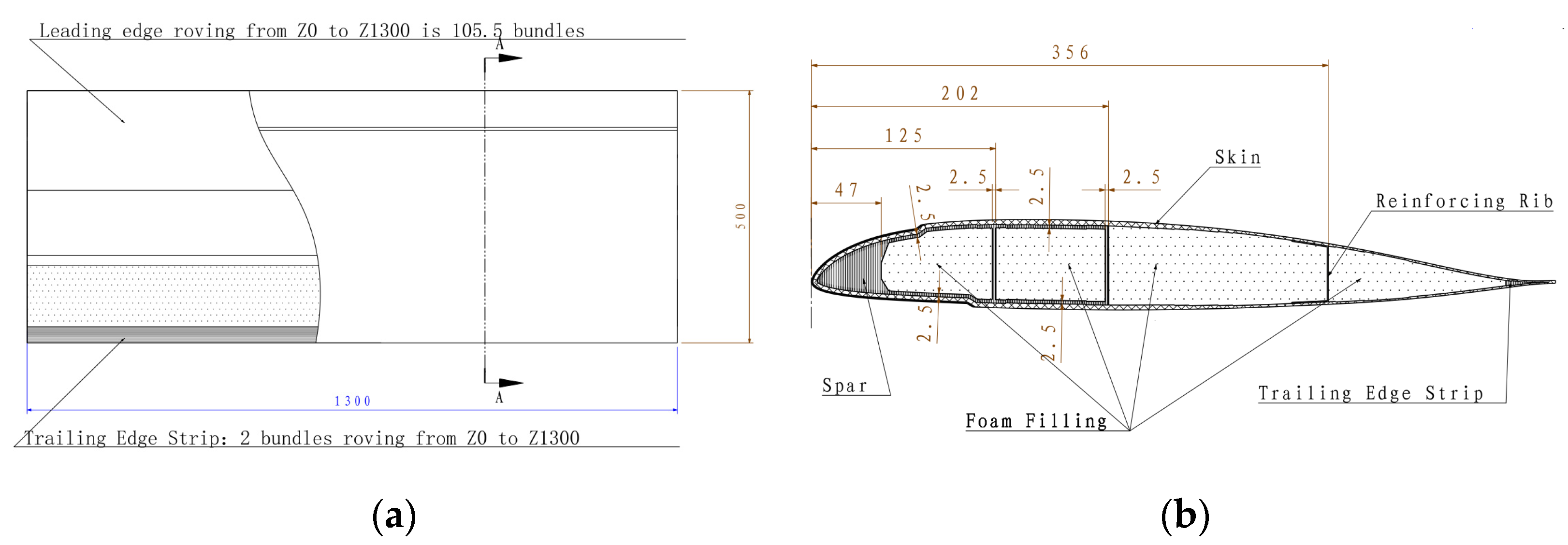

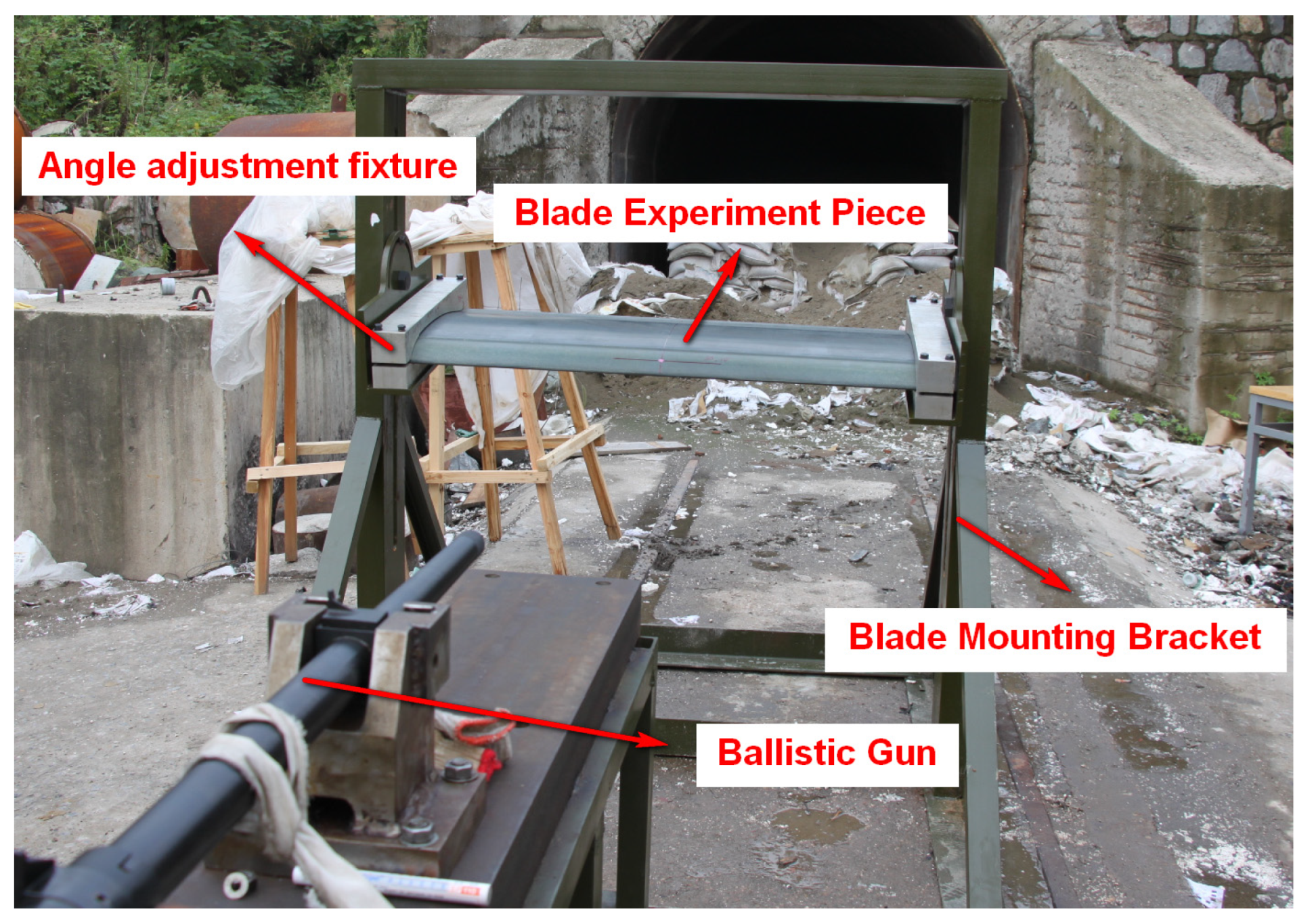




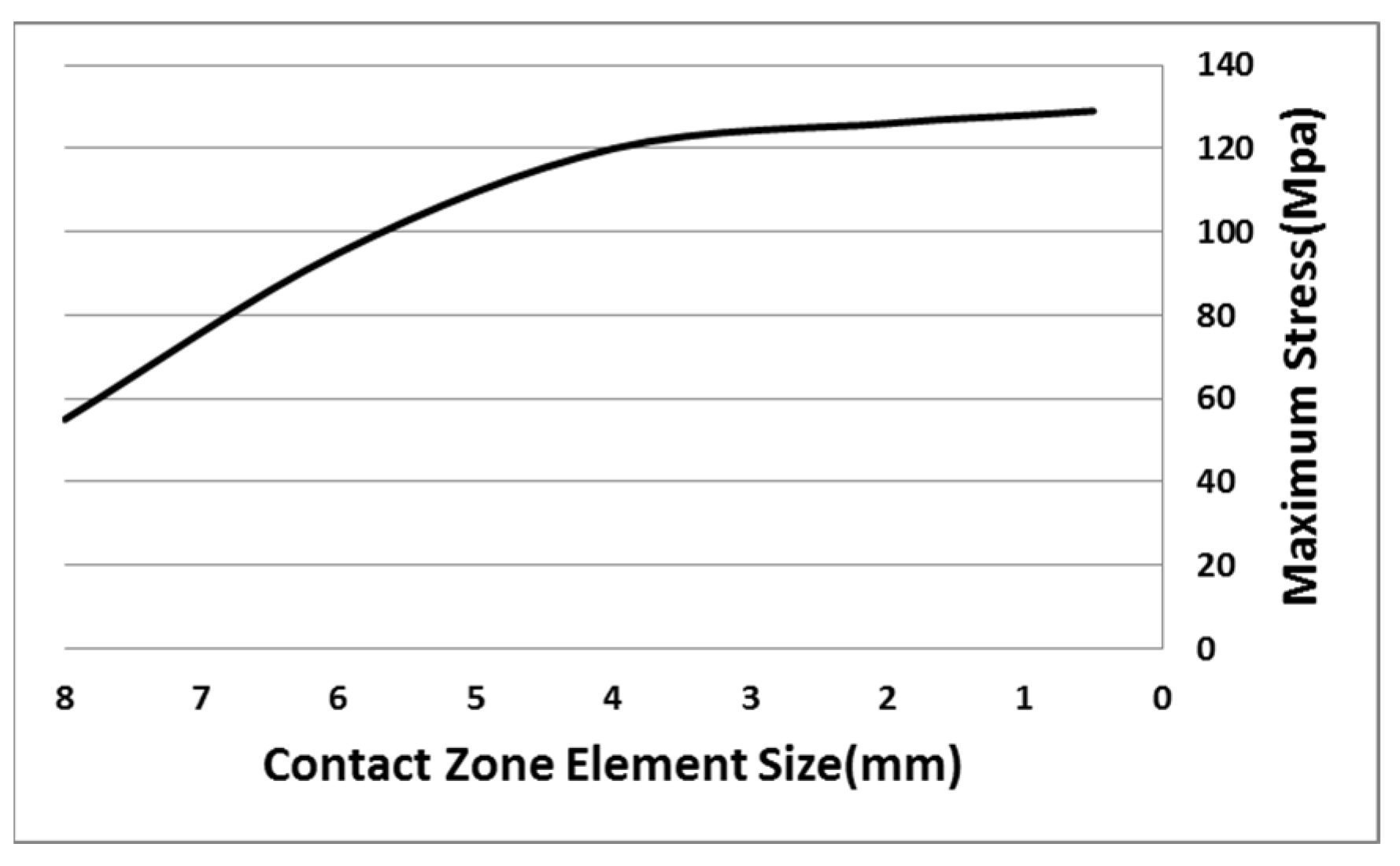
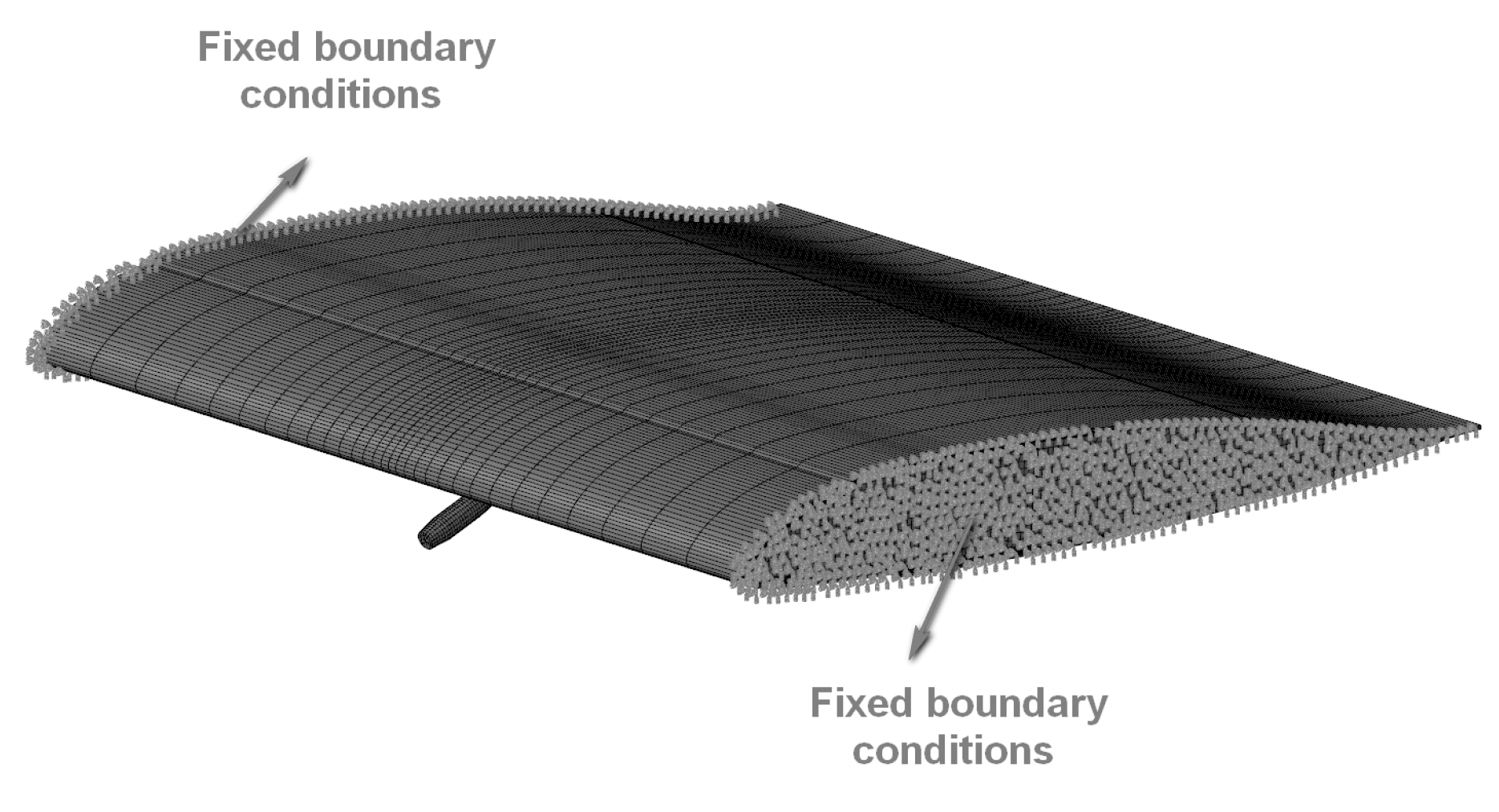
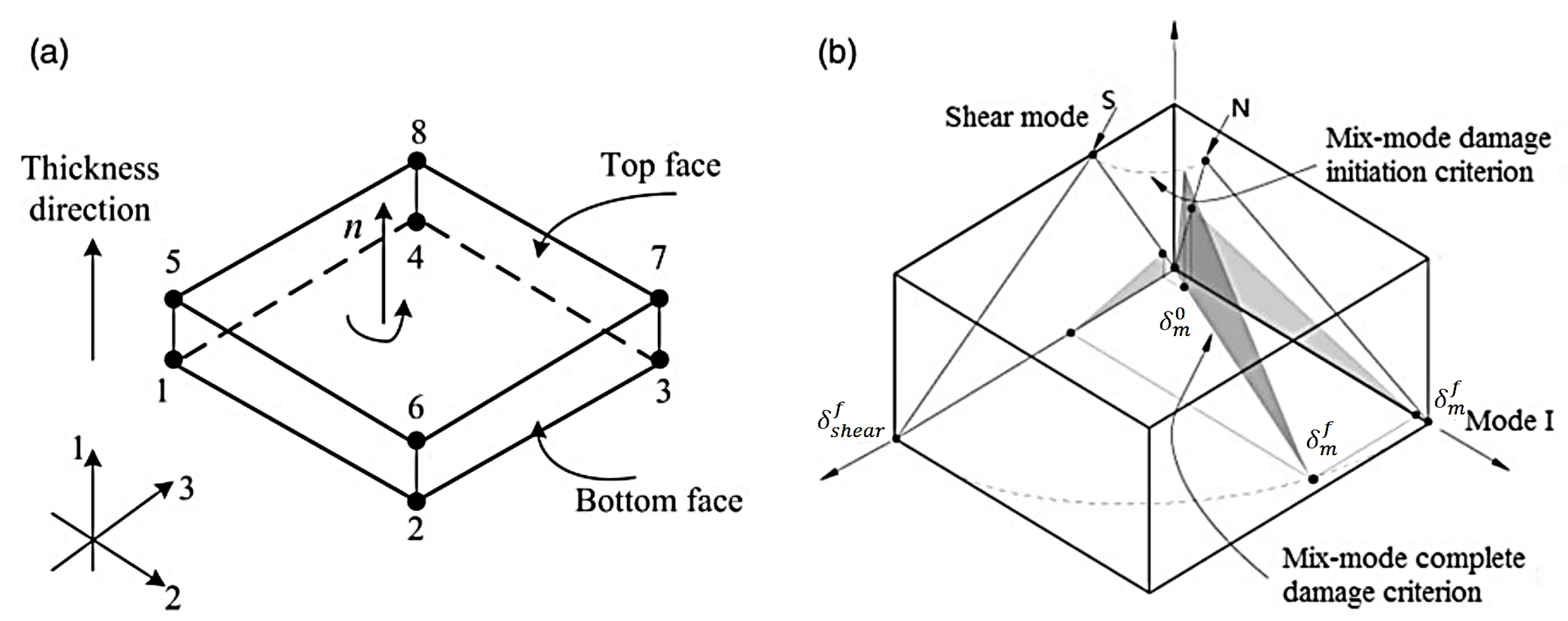
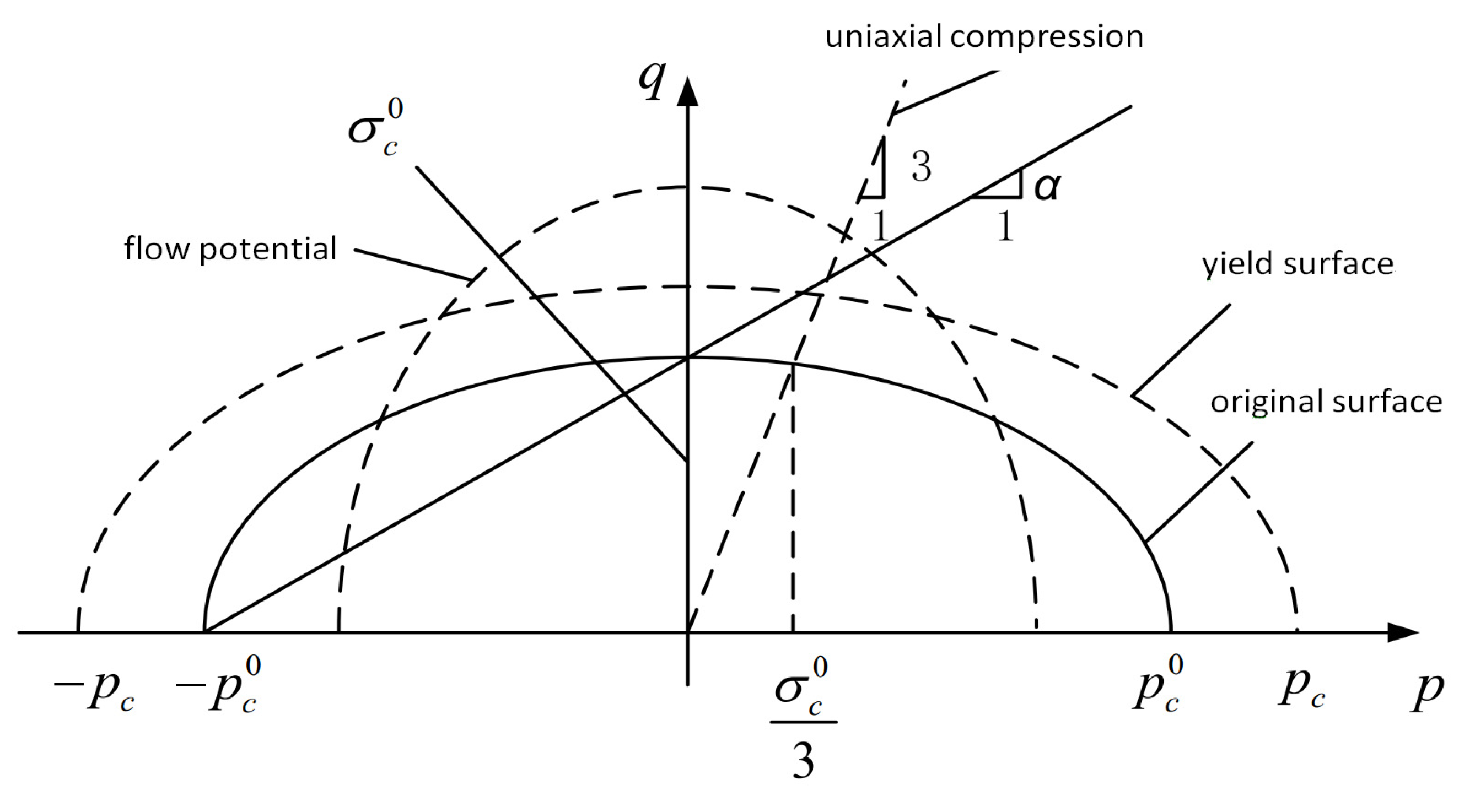
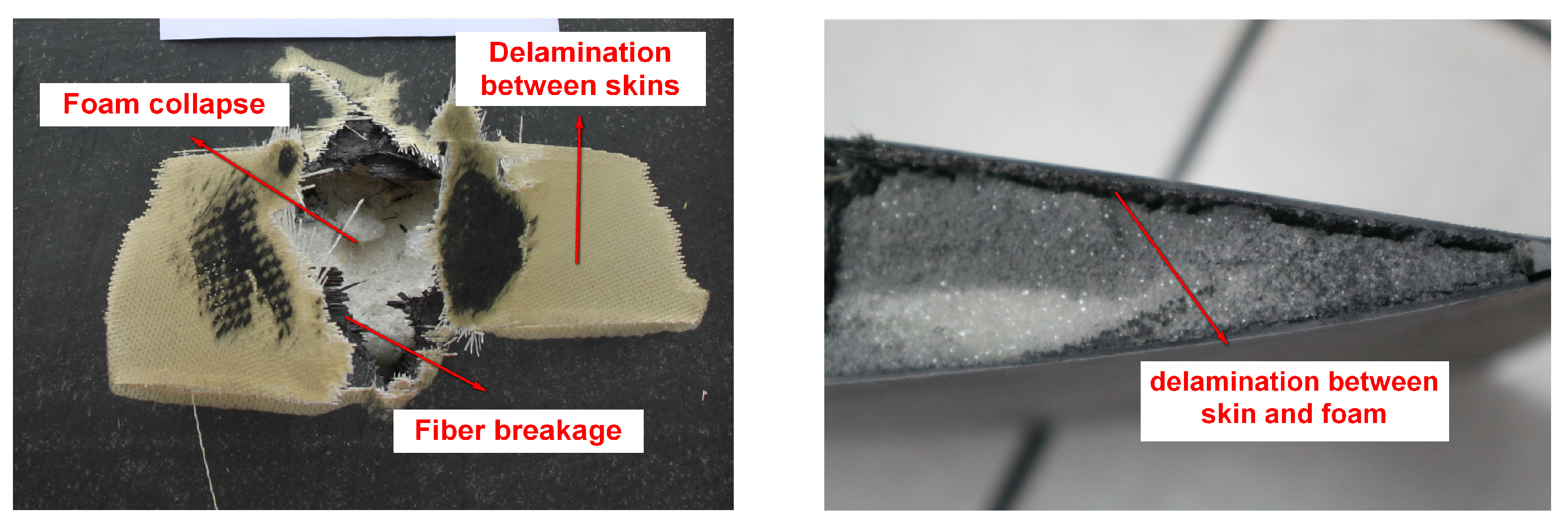


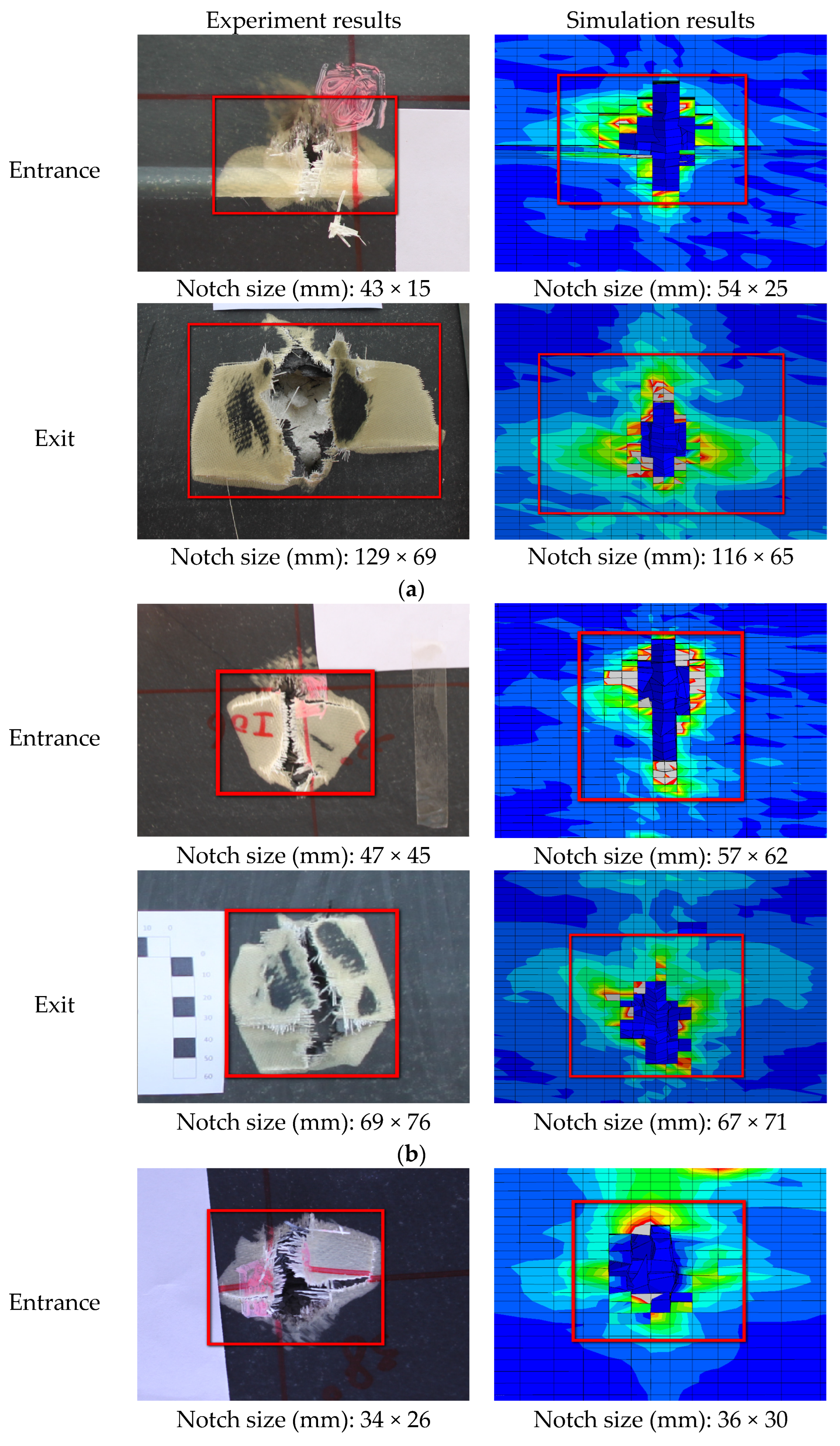
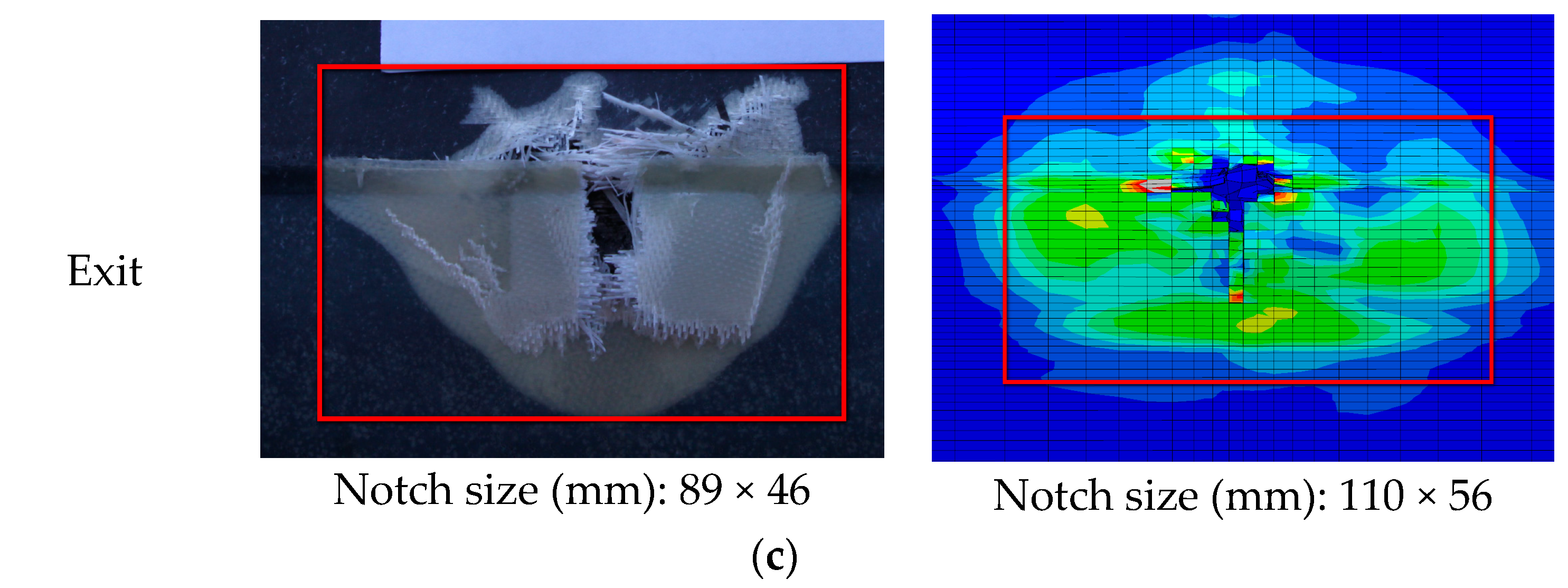
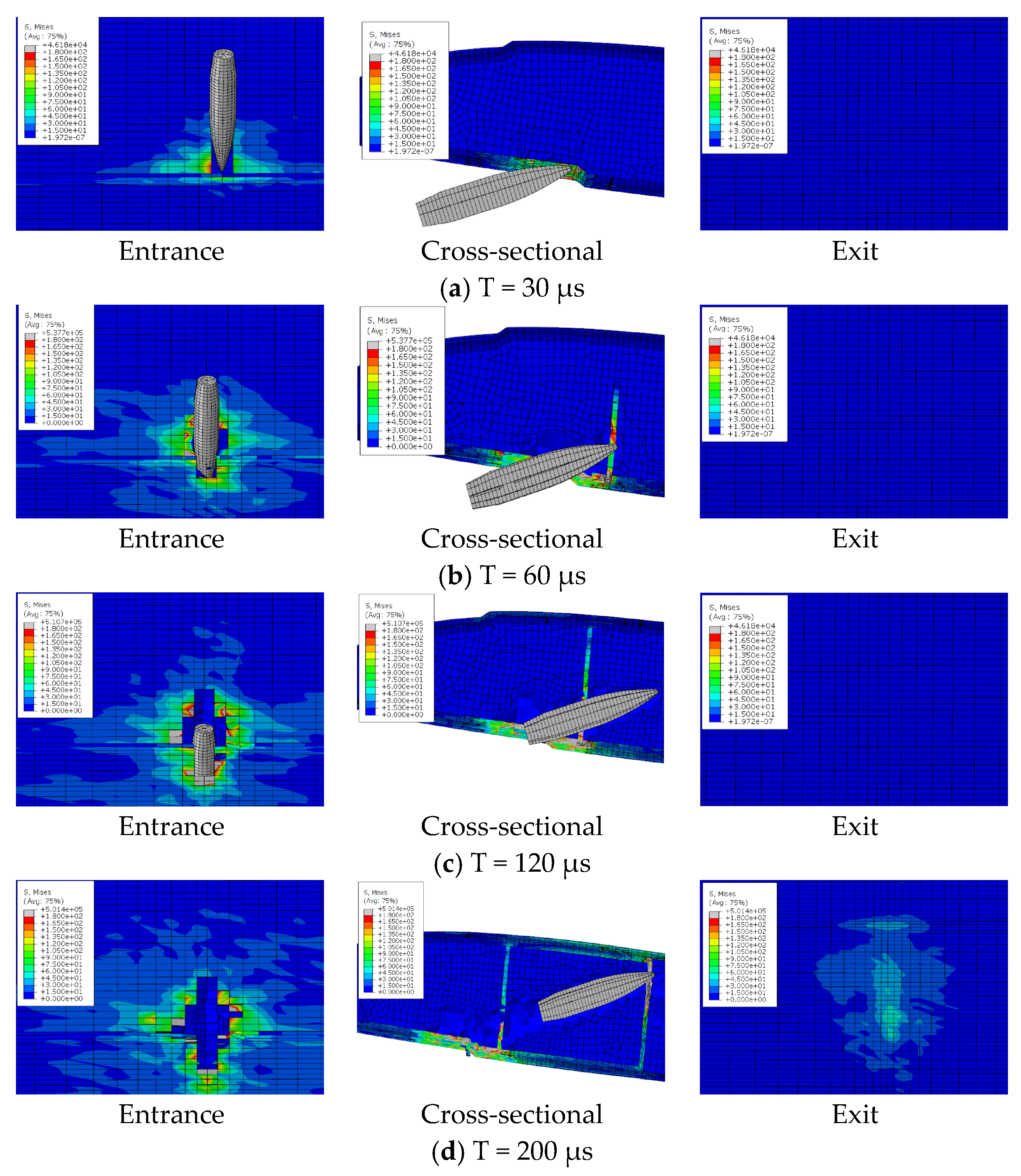


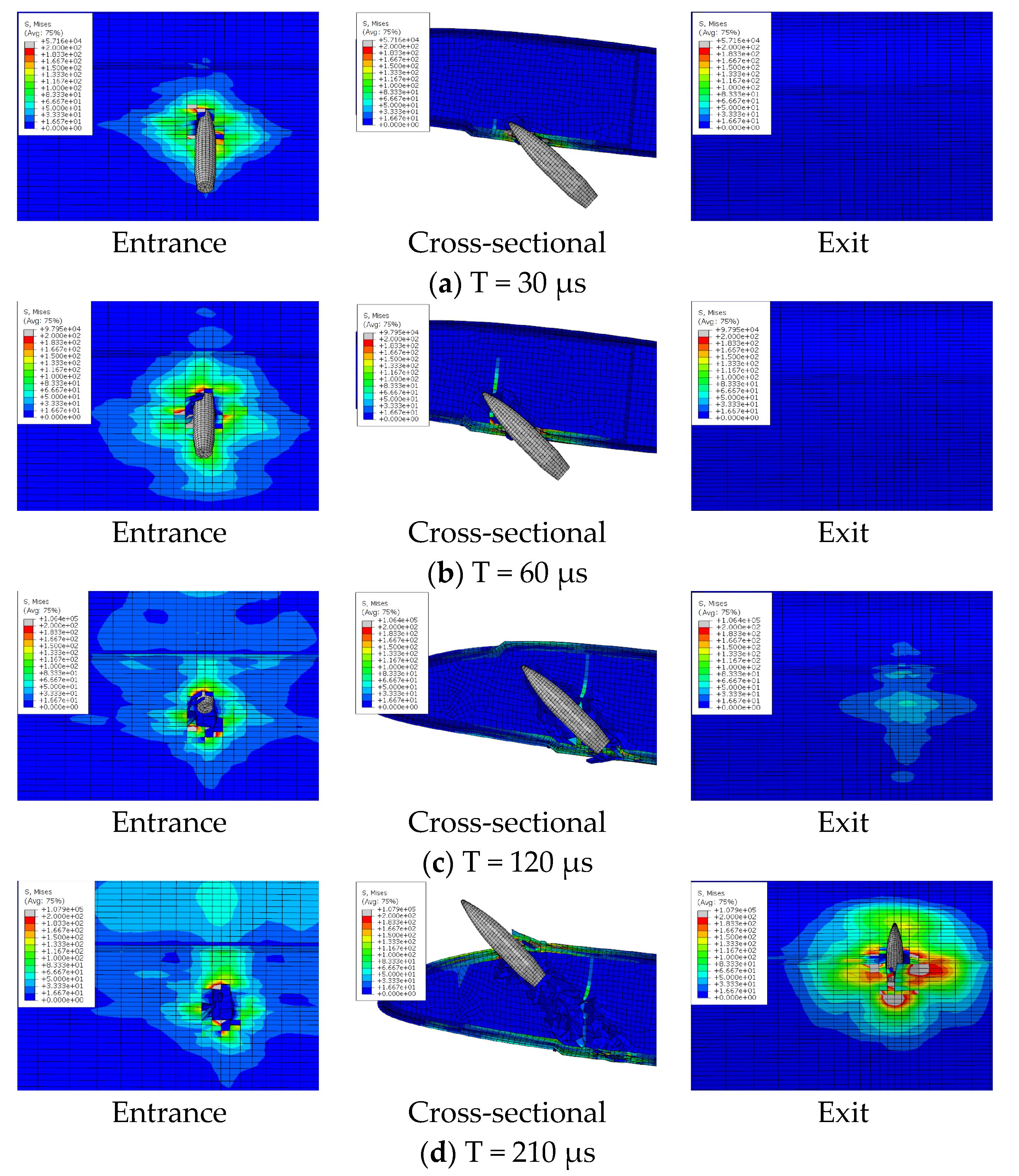



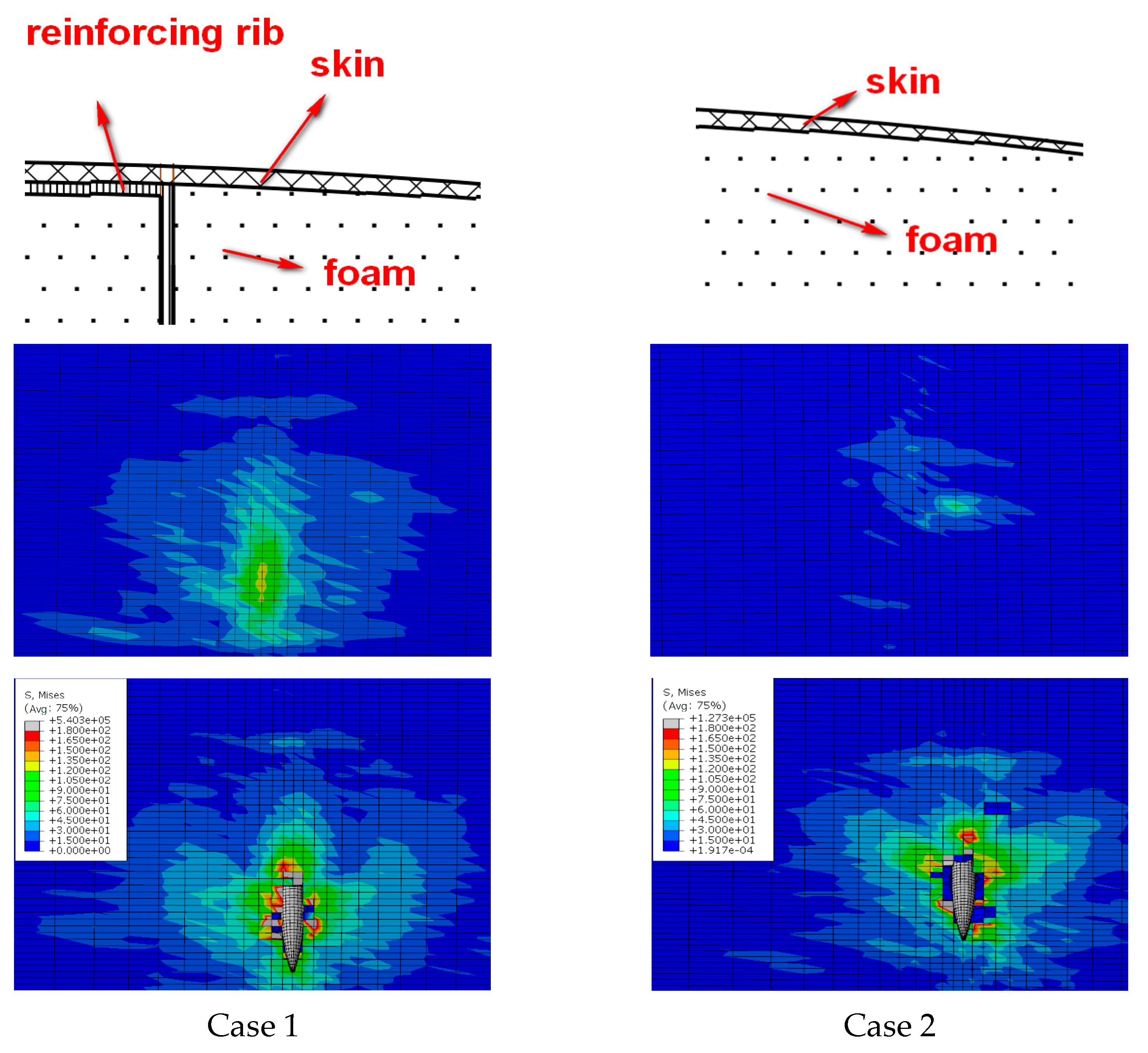
| Property | EW250F/Epoxy | CF3052/Epoxy | S4C10-800/Epoxy | Property | EW250F/Epoxy | CF3052/Epoxy | S4C10-800/Epoxy |
|---|---|---|---|---|---|---|---|
| 25 | 50.4 | 57 | 380 | 520 | 1350 | ||
| 25 | 50.4 | 13 | 380 | 380 | 700 | ||
| 3 | 6.8 | 13 | 380 | 520 | 50 | ||
| 0.14 | 0.08 | 0.3 | 380 | 380 | 200 | ||
| 0.2 | 0.35 | 0.3 | 33.6 | 33.6 | 50 | ||
| 0.2 | 0.35 | 0.33 | 93.6 | 93.6 | 200 | ||
| 4.5 | 3.13 | 5.5 | 80 | 80 | 52 | ||
| 2.4 | 2.78 | 5.5 | 49 | 62 | 52 | ||
| 2.4 | 2.78 | 5.5 | 49 | 62 | 50 |
| Property | Value | Property | Value |
|---|---|---|---|
| 5 | 30 | ||
| 5 | 0.6 | ||
| 30 | 2.1 |
| Property | Value | Property | Value |
|---|---|---|---|
| 92 | 30 | ||
| 29 | 75 | ||
| 2.8 | 0.3 | ||
| 1.5 | 0 | ||
| 1.3 | 1.5 |
| Material | Damage Model | Stiffness Reduction Scheme |
|---|---|---|
| Spar | Fiber failure | E1 = 0.1E1 |
| Matrix failure | E2 = 0.2E2, E3 = 0.2E3, G12 = 0.2G12, G23 = 0.2G23 | |
| Skin | Warp failure | E1 = 0.1E1, G12 = 0.1G12, G13 = 0.1G13, 12 = 0.112,13 = 0.113 |
| Weft failure | E2 = 0.1E2, G12 = 0.1G12, G23 = 0.1G23, 12 = 0.112,23 = 0.123 | |
| Matrix failure | E3 = 0.2E3, G12 = 0.2G12, G23 = 0.2G23 |
Disclaimer/Publisher’s Note: The statements, opinions and data contained in all publications are solely those of the individual author(s) and contributor(s) and not of MDPI and/or the editor(s). MDPI and/or the editor(s) disclaim responsibility for any injury to people or property resulting from any ideas, methods, instructions or products referred to in the content. |
© 2024 by the authors. Licensee MDPI, Basel, Switzerland. This article is an open access article distributed under the terms and conditions of the Creative Commons Attribution (CC BY) license (https://creativecommons.org/licenses/by/4.0/).
Share and Cite
Yu, G.; Li, X.; Huang, W. Performance and Damage Study of Composite Rotor Blades under Impact. Polymers 2024, 16, 623. https://doi.org/10.3390/polym16050623
Yu G, Li X, Huang W. Performance and Damage Study of Composite Rotor Blades under Impact. Polymers. 2024; 16(5):623. https://doi.org/10.3390/polym16050623
Chicago/Turabian StyleYu, Guorui, Xiaobin Li, and Wenjun Huang. 2024. "Performance and Damage Study of Composite Rotor Blades under Impact" Polymers 16, no. 5: 623. https://doi.org/10.3390/polym16050623
APA StyleYu, G., Li, X., & Huang, W. (2024). Performance and Damage Study of Composite Rotor Blades under Impact. Polymers, 16(5), 623. https://doi.org/10.3390/polym16050623







